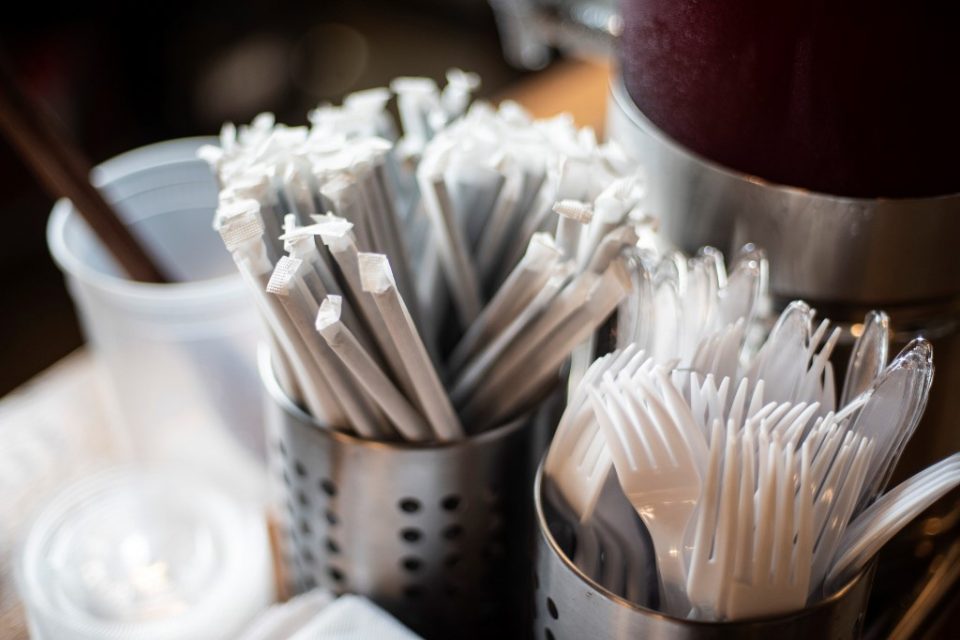
by Sébastien DUVAL
WASHINGTON, United States (AFP) — “How do you drink a milkshake without a straw?”
It is a question the city of Washington will soon face after deciding, in the interest of the environment, to ban plastic drinking straws — an almost sacrilegious act in the birthplace of this simple object, a seemingly indispensable part of daily American life.
In the last century, millions of straws were produced in the Stone Straw Building, a stolid-looking structure of yellowing brick in a residential neighborhood. The building now houses the capital’s transit police headquarters.
The only visible sign of its historic character comes from a discreet commemorative plaque affixed to a wall above a garbage bin that honors the memory of Marvin C. Stone, “Inventor of the Paper Straw.”
According to legend, Stone, who settled in Washington after being wounded while fighting for the Union side in the Civil War, had the inspiration one evening while sipping on his favorite cocktail, a mint julep.
At that time, people sometimes used actual straws — dried lengths of ryegrass — for drinking, but Stone was put off by the inescapable rye-flavored residue they imparted.
So he adapted a machine already in use for making paper cigarette holders, instead wrapping spirals of paper around a pencil-like cylinder, attaching the ends with wax and then removing the cylinder.
He filed for a patent in 1888 — the objective, he said in his application, was to create a “cheap, durable and unobjectionable substitute for natural straws commonly used for the administration of medicines, beverages, &c.” — and the rest is history.
But almost a century and a half later, his ungrateful adoptive home became the second large US city, after Seattle, to ban the plastic descendants of Stone’s popular invention.
The ban technically took effect January 1 but it came with a grace period, meant to ease the transition for restaurants and businesses, that ends July 1.
Everything ‘to go’
“A lot of businesses are still using plastic straws and don’t have a strategy,” said Kirk Francis, who manages the Tastemakers food hall in a former mayonnaise factory adjoining the Stone Straw Building.
The young, environmentally minded entrepreneur faced the same existential question years ago when he launched “Captain Cookie and the Milk Man,” a food truck selling baked treats and dairy products: “How do you drink a milkshake without a straw?”
He considered straws of metal, of biodegradable paper or of vegetable-based material — many of them more expensive or flimsier than those of plastic — and says he has yet to find a “good solution.”
The youthful “Captain” Kirk, who wears a Cookie Monster cap over his curly brown hair, knows that most of his customers don’t really care that much: “Customers want a straw that works well.”
So getting people to give up their straws will not be easy. They have been an inextricable part of American culture since they were first promoted as a way to curb the spread of disease at a time when people would share a common cup when drinking from public fountains.
Another American, Joseph Friedman, elaborated on Stone’s invention in the 1930s after watching his daughter struggle with a milkshake. His modification, the flexible straw, has grown in popularity alongside other mainstays of Americans’ consumer culture: soda fountains, carry-out food, iced drinks with lots of ice.
Plastic on plastic
The ban on plastic straws is really just a symbolic beginning, said Sarah Perrin, a Tastemakers customer, who was with her young daughter. Five-year-old Lily was using a plastic straw to sip fruit juice from a plastic cup topped with a plastic lid.
“Without a straw, she would spill it all over,” her mother said.
“The straw ban comes from a good intention, but what about disabled people and kids?” Perrin asked. “It can help us feeling better about ourselves, but does it really make a difference for the environment if we don’t target the corporations first?”
Collin Odell, sitting with his dog on the food hall’s terrace — with a view of Marvin Stone’s old factory — was also using a plastic straw as he drank a guava juice beverage with plenty of ice.
“It came with my order!” the young resident of Brookland, a fast gentrifying neighborhood, explained a bit defensively.
“I’m fully on board with the ban, if it can help reduce the massive amount of garbage in the oceans,” he said.
Odell said he is seeing fewer plastic straws in Washington.
“But it’s not the case elsewhere in the country.
“I’m always amazed when I travel outside of DC to be served in Styrofoam cups” — yet another very American obsession.
© Agence France-Presse







